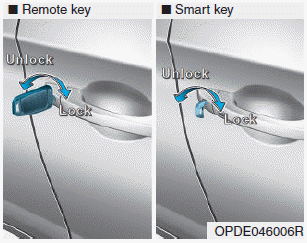Hyundai i-30: Emission Control System / Description and operation
Hyundai i30 (PD) 2018-2025 Service Manual / Emission Control System / Description and operation
| Description |
Emissions control system consists of the three major systems.
| • |
Crankcase emission control system prevents blow-by gas from going into
the atmosphere. This system burns these gases after moving them to the
intake manifold (Closed crankcase ventilation type).
|
| • |
Evaporative emission control system prevents evaporative gas going into
the atmosphere. This system burns the gases at appropriate engine operating
condition after gathering it in the canister.
|
| • |
Exhaust emission control system converts the three pollutants hydrocarbons
(HC), carbon monoxide (CO), and oxides of nitrogen (NOx) into harmless
substances by using the 3-way catalytic converter.
|
 Specifications
Specifications
Specifications
Purge Control Solenoid Valve (PCSV)
▷ Specification
Item
Specification
Coil resistance (Ω)
12...
Other information:
Hyundai i30 (PD) 2018-2025 Service Manual: Troubleshooting
Troubleshooting Problem Symptoms Table Use the table below to help you find the cause of the problem. The numbers indicate the priority of the like cause of the problem. Check each part in order. If necessary, replace these parts...
Hyundai i30 (PD) 2018-2025 Service Manual: Heater Core
Repair procedures Replacement 1. Disconnect the negative (-) battery terminal. 2. Remove the heater and blower assembly. (Refer to Heater - "Heater Unit") 3...
Categories
- Manuals Home
- 3rd Generation i30 Owners Manual
- 3rd Generation i30 Service Manual
- Shift-lock system. Shift-lock release
- Auto door lock/unlock features
- LKA system operation
- New on site
- Most important about car
Door locks
Operating door locks from outside the vehicle
Mechanical key

Turn the key toward the rear of the vehicle to unlock and toward the front of the vehicle to lock.
If you lock/unlock the driver's door with a key, a driver’s door will lock/unlock automatically.
Copyright © 2025 www.hi30.net

